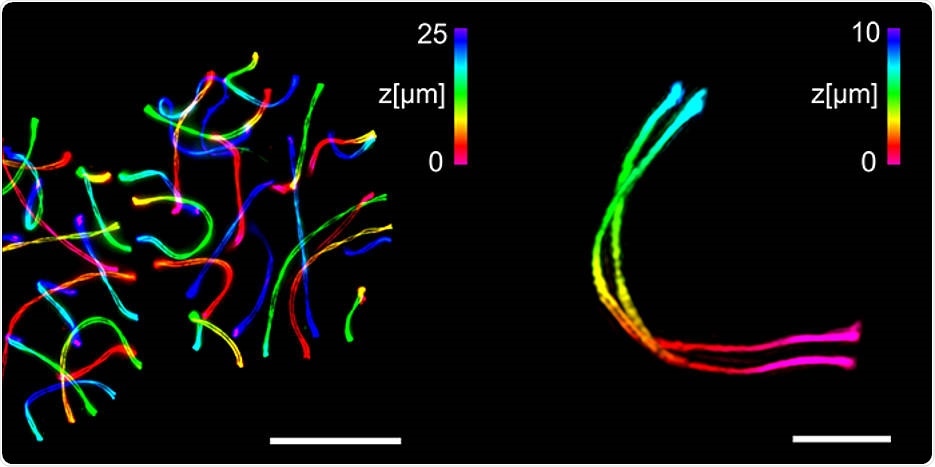The development of egg and sperm cells in all mammals, including humans, is significantly contributed by the synaptonemal complex—a ladder-like cell structure.

Left two sperm-forming cells expanded with ExM-SIM and imaged with diffraction-limited microscope. On the right, a detailed 3D image of a single synaptonemal complex. The 3D information is color-coded; the measuring bar on the left corresponds to 25 micrometers, the bar on the right to 3 micrometers. Image Credit: Working groups of Benavente and Sauer/University of Würzburg.
The structure of this complex has hardly been changed in evolution, but its protein components vary greatly from organism to organism.”
Ricardo Benavente, Professor and Cell and Developmental Biologist, Biocenter of Julius-Maximilians-Universität Würzburg
This underscores the fact that the structure is important for the uninterrupted function of the complex. Benavente is now analyzing the synaptonemal complex along with Markus Sauer, a Professor of Biotechnology and Biophysics at the Biocenter of Julius-Maximilians-Universität Würzburg (JMU Biocenter).
The latest discoveries of the two research teams have been published in the Nature Communications journal.
The data denotes, among other things, that in mouse, the synaptonemal complex is not double-layered, as previously believed, but much more complex.
A sophisticated combination of microscopy techniques
In our study, we combined structured illumination microscopy SIM with various methods of expansion microscopy ExM.”
Markus Sauer, Professor of Biotechnology and Biophysics, Biocenter of Julius-Maximilians-Universität Würzburg
Sauer is also an expert in high-resolution microscopy.
The ExM allows greater resolution by integrating the target structures into a swellable polymer that can be physically extended by around four times.
For the first time, the combination of ExM and SIM allowed the scientists to observe the three-dimensional (3D) ultrastructure of the synaptonemal complex through multicolor imaging with a spatial resolution of 20 to 30 nm.
According to Benavente and Sauer, “If immunolabeling is performed after the expansion of the complex, the antibody accessibility can be improved compared to other high-resolution methods. This has enabled us to decipher details of the molecular organization that were previously hidden.”
Moreover, it is now possible to capture the images close to a molecular resolution on a regular light microscope.
The JMU research groups are now looking to use the combination of ExM and IM to discover more details about the synaptonemal complex and other kinds of multi-protein complexes.
Source:
Journal reference:
Zwettler, F. U., et al. (2020) Tracking down the molecular architecture of the synaptonemal complex by expansion microscopy. Nature Communications. doi.org/10.1038/s41467-020-17017-7.